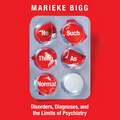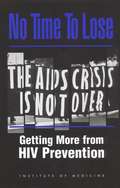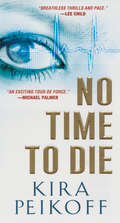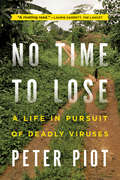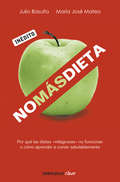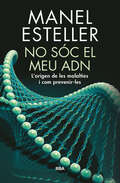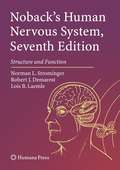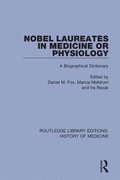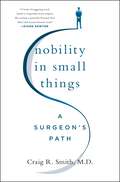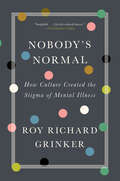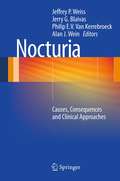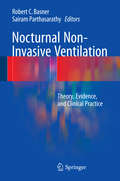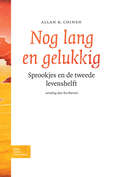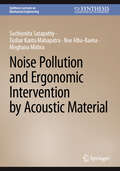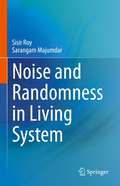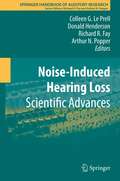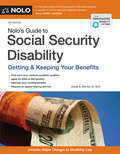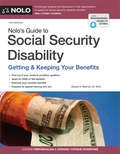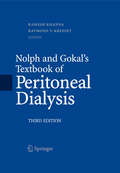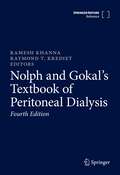- Table View
- List View
No Saints around Here: A Caregiver’s Days
by Susan Allen TothWhen we promise &“in sickness and in health,&” it may be a mercy that we don&’t know exactly what lies ahead. Forcing food on an increasingly recalcitrant spouse. Brushing his teeth. Watching someone you love more than ever slip away day by day. As her husband James&’s Parkinson&’s disease with eventual dementia began to progress, writer Susan Allen Toth decides she intensely wants to keep her husband at home—the home he designed and loved and lived in for a quarter century—until the end.No saint, as she often reminds the reader, Toth found solace in documenting her days as a caregiver. The result, written in brief, episodic bursts during the final eighteen months of James&’s life, has a rare and poignant immediacy. Wrenching, occasionally peevish, at times darkly funny, and always deeply felt, Toth&’s intimate, unsparing account reflects the realities of seeing a loved one out of life: the critical support of some friends and the disappearance of others; the elasticity of time, infinitely slow and yet in such short supply; the sheer physicality of James&’s decline and the author&’s own loneliness; the practical challenges—the right food, the right wheelchair, the right hospital bed—all intricately interlocking parts of the act of loving and caring for someone who in so many ways is fading away.&“We all need someone to hear us,&” Toth says of the millions who devote their days to the care of a loved one. Her memoir is at once an eloquent expression of that need and an opening for others. No Saints around Here is the beginning of a conversation in which so many of us may someday find our voices.
No Such Thing as Normal: Disorders, Diagnoses, and the Limits of Psychiatry
by Marieke BiggExposing the false promises of psychiatry and the crumbling foundations on which it was builtPsychiatry rests on the belief that mental distress can ultimately be explained by biology: brain structures, chemical imbalances and genetics. Treatments from lobotomies to electroconvulsive therapy to prescription drugs have been touted as cures for 'disorder'. And somewhere along the way, the pharmaceutical industry has leapfrogged its patients, making millions designing drugs to treat disorders, then billions dreaming up disorders that require drugs. We are now diagnosed and treated for mental disorders more than ever, despite increasing evidence that environmental factors play a far greater role than biological ones. Laying out the steps for a mental health system that helps rather than harms, Marieke Bigg asks: how can we heal when faced with an industry that banks on keeping us sick?
No Time To Lose: Getting More from HIV Prevention
by Committee on HIV Prevention Strategies in the United StatesThe United States has spent two productive decades implementing a variety of prevention programs. While these efforts have slowed the rate of infection, challenges remain. The United States must refocus its efforts to contain the spread of HIV and AIDS in a way that would prevent as many new HIV infections as possible. No Time to Lose presents the Institute of Medicine’s framework for a national prevention strategy.
No Time to Die
by Kira Peikoff"Fans of Michael Crichton will love this heart-pounding thriller." —Joseph FinderIn a Washington, D.C. research lab, a brilliant scientist is attacked by his own test subjects. At Columbia University, a talented biochemist is lured out of her apartment and never seen again. In the Justice Department's new Bioethics Committee, agent Les Mahler sees a sinister pattern emerging. . .Zoe Kincaid is a petite college student whose rare genetic makeup may hold the key to a powerful medical breakthrough. When she is kidnapped, the very thing mankind has wanted since the dawn of time threatens to unleash our final destruction."A crackling good read. . .terrific and totally unexpected."—Michael Palmer"A twisting, suspenseful thriller." —William Landay
No Time to Lose: A Life in Pursuit of Deadly Viruses
by Peter PiotAs a young scientist, Peter Piot named a newly discovered virus "ebola." This is the story of his extraordinary career. When Peter Piot was in medical school, a professor warned, "There's no future in infectious diseases. They've all been solved." Fortunately, Piot ignored him, and the result has been an exceptional, adventure-filled career. In the 1970s, as a young man, Piot was sent to Central Africa as part of a team tasked with identifying a grisly new virus. Crossing into the quarantine zone on the most dangerous missions, he studied local customs to determine how this disease--the Ebola virus--was spreading. Later, Piot found himself in the field again when another mysterious epidemic broke out: AIDS. He traveled throughout Africa, leading the first international AIDS initiatives there. Then, as founder and director of UNAIDS, he negotiated policies with leaders from Fidel Castro to Thabo Mbeki and helped turn the tide of the epidemic. Candid and engrossing, No Time to Lose captures the urgency and excitement of being on the front lines in the fight against today's deadliest diseases.
No Way Out of This: Loving a Partner with Alzheimer's
by Sue Fagalde LickNo Way Out of This is not the kind of Alzheimer’s memoir where you read about a noble, self-sacrificing wife who gives up everything to take care of her husband. We see such spouses in books and movies—but they’re not telling the whole story. Nobody’s that good. Certainly Sue Lick isn’t. Sue’s much-older husband, Fred, is a forgetful man. She’s always found that charming. But when his absentmindedness worsens into full-blown dementia, she suddenly finds herself dealing with his illness alone. Struggling to care for Fred and manage their two loveable but incorrigible dogs and still find time to write and play music, Sue constantly faces impossible choices. Tell people about his illness? Let him drive? Put him in an institution? Treat his medical problems, or let him go? Every decision feels wrong—but in the end, their love carries them through it all.More than 6 million Americans suffer from dementia. One in three seniors have it. Add in the spouses, siblings, adult children, and professionals responsible for their care, and we all have a stake in this story. While some caregivers have loving families to support them and enough money to pay for the best care, more often the situation is a lot messier. Here the author, a longtime journalist, tells the truth about nursing homes, Medicaid, mental health, and more.
No enfermar nunca más: Cómo fortalecer tu sistema inmunológico
by Dr Angela FetznerEs cierto que el título «No enfermar nunca más» puede sonar provocador. Pero seguramente ya habrás notado que algunas personas parecen no ponerse nunca enfermas, mientras que otras se contagian de cada infección que hay a su alrededor. ¿Resfriarse es una consecuencia inevitable para algunos de nosotros solo con que haya suficientes virus y bacterias en movimiento? ¡En absoluto! Solo tenemos que ofrecer a nuestro sistema inmunológico las herramientas y los medios adecuados para poder resistir a los virus y las bacterias. Hay toda una gama de trucos y terapias simples y eficaces para fortalecer las defensas del cuerpo y así crear una barrera segura frente a enfermedades desagradables. Si te tomas estas medidas en serio, tu cuerpo rechazará claramente todas las enfermedades por resfriado en un tiempo sorprendentemente corto y al mismo tiempo te pondrás en forma, serás más eficiente y experimentarás una sensación corporal y un bienestar completamente nuevos.
No más dieta: Por qué las dietas «milagrosas» no funcionan o cómo aprender a comer saludableme
by Julio Basulto M.ª José MateoCómo no caer en las dietas fraudulentas y aprender las pautas para una dieta anti-mitos. Dietas para tener salud Dietas para perder peso Dietas para esculpir el cuerpo Dietas para recuperar la juventud ¿Hay dietas para comer bien? En el mundo actual, la creciente preocupación por el comer sano choca de frente con un estilo de vida que se caracteriza por la acuciante falta de tiempo. Esto ha abonado el terreno para la aparición de infinidad de dietas «milagrosas» que, en la mayoría de los casos, no pasan de ser un simple fraude. El prestigioso dietista-nutricionista Julio Basulto, con la colaboración de María José Mateo, desmonta los mitos de las dietas rápidas con una sólida base científica, y nos propone unas pautas para una alimentación sensata, acompañadas de una serie de recomendaciones sobre cómo perder peso de forma saludable.
No solo covid: No solo covid
by Claudio CalzoniNo solo covid por Claudio Calzoni Hay enfermedades que priman en los medios y en las redes sociales mientras que otras muchas quedan relegadas y casi olvidadas, como si fueran pasajeras y poco debilitantes. Claudio Calzoni testimonia una de ellas a través de las notas de su diario, lleno de poesía y sufrimiento.
No sóc el meu ADN: L'origen de les malalties i com prevenir-les
by Manel EstellerL’epigenètica a l’abast de tothom de la mà del científic més destacat en la matèria. Puc heretar les malalties dels meus pares o avis? És possible que els meus fills heretin les meves? Fins a quin punt una disciplina com l’epigenètica pot repercutir en la prevenció i el tractament de malalties com el càncer i l’Alzheimer? I, sobretot, què és l’epigenètica? __________________________ Manel Esteller, tot un referent internacional en l’àmbit de l’epigenètica i un excel·lent comunicador, respon en aquest llibre a aquestes preguntes i a moltes altres d’una manera il·lustrativa i divulgativa. A partir de dotze exemples basats en casos reals i quotidians, Esteller exposa les claus per entendre millor les bases d’aquesta disciplina científica i ofereix un panorama de les infinites possibilitats que genera l’estudi de l’epigenètica. D’aquesta manera, els conceptes teòrics troben la seva aplicació pràctica en consells per portar una vida saludable que ens permeti, en la mesura del possible, prevenir el desenvolupament d’aquestes malalties.
Noback's Human Nervous System, Seventh Edition
by Robert J. Demarest Lois B. Laemle Norman L. StromingerWith this seventh edition, Noback's Human Nervous System: Structure and Function continues to combine clear prose with exceptional original illustrations that provide a concise lucid depiction of the human nervous system. The book incorporates recent advances in neurobiology and molecular biology. Several chapters have been substantially revised. These include Development and Growth, Blood Circulation and Imaging, Cranial Nerves and Chemical Senses, Auditory and Vestibular Systems, Visual System, and Cerebral Cortex. Topics such as neural regeneration, plasticity and brain imaging are discussed. Each edition of The Human Nervous System has featured a set of outstanding illustrations drawn by premier medical artist Robert J. Demarest. Many of the figures from past editions have been modified and/or enhanced by the addition of color, which provides a more detailed visualization of the nervous system. Highly praised in its earlier versions, this new edition offers medical, dental, allied health science and psychology students a readily understandable and organized view of the bewilderingly complex awe-inspiring human nervous system. Its explanatory power and visual insight make this book an indispensable source of quick understanding that readers will consult gratefully again and again.
Nobel Laureates in Medicine or Physiology: A Biographical Dictionary (Routledge Library Editions: History of Medicine #5)
by Daniel M. Fox Marcia Meldrum Ira RezakOriginally published in 1990, Nobel Laureates in Medicine or Physiology is a biographical reference work about the recipients of Nobel Prizes in Medicine or Physiology from 1901-1989. Each article is written by an accomplished historian of medicine or science. The book is designed to be accessible to students and general readers as well as to specialists in medical science and history. Each article combines personal and scientific biography, and each has an extensive biography to guide further reading and research.
Nobility in Small Things: A Surgeon's Path
by Craig R. Smith M.D.His routine was the same every day for 38 years: up at 4:15, make a turkey-on-rye, drive the deserted Henry Hudson Parkway to the hospital, check the schedule, scrub, cut, reattach, save a life or two, repeat. Until March 2020, when the Covid-19 pandemic shut hospital surgeries all over the world.Craig Smith, M.D., Chairman of the Department of Surgery at Columbia Presbyterian Hospital, went from performing heart surgeries on patients both everyday and celebrated (he performed the quadruple bypass that saved Bill Clinton’s life in 2004) to sitting in his tomb-quiet office looking out at George Washington Bridge. And he started to write. His Covid emails were balm to the staffers and later became celebrated for Dr. Smith’s care and thought in his assessment of the work of the hospital–of any hospital.Nobility in Small Things not only takes us into the mind and soul of a surgeon with the ability to “play God” but into the heart of a man who chose a lifesaving career. The book introduces us to patients and peers, and moves from family-building and heartbreak at home, to the tragic suicide of two fellow M.D.s. Dr. Smith also writes vulnerably about his debilitating social anxiety and how he overcame it.Dr. Smith shows us not just the making of a surgeon in Nobility in Small Things, but the maintenance of one: the deep feeling and moral philosophy that anchor the daily miracles that define his profession.
Nobody's Normal: How Culture Created The Stigma Of Mental Illness
by Roy Richard GrinkerA compassionate and captivating examination of evolving attitudes toward mental illness throughout history and the fight to end the stigma. For centuries, scientists and society cast moral judgments on anyone deemed mentally ill, confining many to asylums. In Nobody’s Normal, anthropologist Roy Richard Grinker chronicles the progress and setbacks in the struggle against mental-illness stigma—from the eighteenth century, through America’s major wars, and into today’s high-tech economy. Nobody’s Normal argues that stigma is a social process that can be explained through cultural history, a process that began the moment we defined mental illness, that we learn from within our communities, and that we ultimately have the power to change. Though the legacies of shame and secrecy are still with us today, Grinker writes that we are at the cusp of ending the marginalization of the mentally ill. In the twenty-first century, mental illnesses are fast becoming a more accepted and visible part of human diversity. Grinker infuses the book with the personal history of his family’s four generations of involvement in psychiatry, including his grandfather’s analysis with Sigmund Freud, his own daughter’s experience with autism, and culminating in his research on neurodiversity. Drawing on cutting-edge science, historical archives, and cross-cultural research in Africa and Asia, Grinker takes readers on an international journey to discover the origins of, and variances in, our cultural response to neurodiversity. Urgent, eye-opening, and ultimately hopeful, Nobody’s Normal explains how we are transforming mental illness and offers a path to end the shadow of stigma.
Nocturia
by Jeffrey P. Weiss, MD, FACS Philip E. Van Kerrebroeck, MD, PhD, MMSc Jerry G. Blaivas Facs, Phd Hon Alan J. Md, Facs, Phd Hon Alan J. WeinNocturia: Causes, Consequences and Clinical Approaches is the first volume exclusively on the topic of nocturia and is designed to be a comprehensive treatise on the subject. The volume is organized into 11 chapters first introducing and defining nocturia and its impact to patients and society, followed by chapters dealing with predictors and risk factors; relationship to sleep disorders; overactive bladder; and water homeostasis. Therapeutic areas addressing nocturia are covered in specific chapters and include pharmacotherapy affecting the bladder, prostate and kidneys as well as behavioral therapy and surgical intervention. Separate chapters are devoted to alternative therapies as well as the impact of nocturia in the elderly. The volume closes with a chapter presenting avenues for future investigation into the etiology and management of nocturia. Clinical case scenarios inclusive of figures and tables illuminate the evaluation and management of patients with nocturia. Nocturia: Causes, Consequences and Clinical Approaches will give physicians and related healthcare providers the background to understand the conditions causing nocturia, how nocturia affects society and the basis for its rational treatment. It will be used as a state of the art reference by urologists, urogynecologists, internists, nephrologists, pulmonologists, endocrinologists and sleep medicine specialists.
Nocturnal Non-Invasive Ventilation
by Robert C. Basner Sairam ParthasarathyThis comprehensive resource brings together the most current theories, evidence and best practice parameters for the use of nocturnal non-invasive ventilation (nNIV). Chapters focus on the application of acute and chronic nNIV in patients with cardio-respiratory disorders over a range of major medical settings. Updates on past and recent research in this field are highlighted. Authored by leading clinicians and investigators, Nocturnal Non-Invasive Ventilation provides practical and cutting-edge knowledge to physicians, researchers and allied health professionals on the front lines of treating cardio-respiratory and sleep disorders.
Nog lang en gelukkig
by Allan ChinonSprookjes zijn eigenlijk gelijkenissen waarin de reis van de mens door het leven wordt uitgebeeld. De meeste sprookjes eindigen met de jeugdige droom van geluk, maar het werkelijke leven eindigt natuurlijk niet met jeugd of eeuwige gelukzaligheid. Ouderdomssprookjes symboliseren de ontwikkelingstaken die de mens moet volbrengen in de tweede levenshelft. Ze gaan over oud worden, maar ook over groei. Ze geven een visie op wat het leven op middelbare en latere leeftijd kan inhouden.
Noise Pollution and Ergonomic Intervention by Acoustic Material (Synthesis Lectures on Mechanical Engineering)
by Noe Alba-Baena Suchismita Satapathy Meghana Mishra Tushar Kanta MahapatraThis book is based on the understanding as well as the use of information technology extensively, to explore OHS related risk in major risky sectors due to noise and a framework is suggested through the systematic analysis of the barriers and its implementations. Ergonomic analysis is done to investigate problems associated with hearing. Acoustic materials are fabricated and tested. A case study is conducted to reduce noise by placing accoustic material.
Noise and Randomness in Living System
by Sisir Roy Sarangam MajumdarThis book illustrates the role of randomness and noise in living organisms. Traditionally, the randomness and noise have been used in understanding signal processing in communications. This book is divided into two sections, the first of which introduces readers to the various types and sources of noise and the constructive role of noise in non-linear dynamics. It also analyses the importance of randomness and noise in a variety of science and engineering applications. In turn, the second section discusses in detail the functional role of noise in biological processes for example, in case of brain function at the level of ion channel, synaptic level and even at cognitive level. These are described in various chapters. One of the challenging issue finding the neuronal correlates of various meditative states is to understand how brain controls various types of noise so as to reach a state of synchronized oscillatory state of the brain corresponding to the state of Samadhi. This is described in details in one chapter called Noise, Coherence and meditation. The concept of noise and the role of randomness in living organism raise lot of controversy for last few decades. This is discussed in a separate chapter. Finally, the epistemic and ontic nature of randomness as discussed in physical science are investigated in the context of living organism.
Noise-Induced Hearing Loss
by Arthur N. Popper Richard R. Fay Donald Henderson Colleen G. Le PrellExposure to loud noise continues to be the largest cause of hearing loss in the adult population. The problem of NIHL impacts a number of disciplines. US standards for permissible noise exposure were originally published in 1968 and remain largely unchanged today. Indeed, permissible noise exposure for US personnel is significantly greater than that allowed in numerous other countries, including for example, Canada, China, Brazil, Mexico, and the European Union. However, there have been a number of discoveries and advances that have increased our understanding of the mechanisms of NIHL. These advances have the potential to impact how NIHL can be prevented and how our noise standards can be made more appropriate.
Nolo's Guide to Social Security Disability: Getting & Keeping Your Benefits
by David A. Morton IIINolo's Guide to Social Security Disability covers the criteria for getting disability benefits for back problems, heart and cardiovascular disease, diabetes, cancer, autoimmune diseases, mental issues like depression and anxiety, and 200 more medical conditions. Learn how to match the medical details of your disability to Social Security regulations to make sure you have the right evidence to qualify for the benefits you're due when you apply. This guide is written by a former Chief Medical Consultant for the Social Security Administration whose expert deciphering of the medical portions of SSA regulations will help you understand how you can get benefits. If you've been denied benefits already, this book will tell you how to find out why and what steps to take to prove that you should get benefits on appeal. This edition is completely updated with the latest rules and information plus updated figures for 2018 and many updated medical listings.
Nolo's Guide to Social Security Disability: Getting & Keeping Your Benefits
by David A. Morton IIIQualify for Social Security disability benefits, quickly and easily Nolo's Guide to Social Security Disability covers the criteria for getting disability benefits for back problems, heart and cardiovascular disease, diabetes, cancer, autoimmune diseases, mental issues like depression and anxiety, and 200 other medical conditions. Learn how to match the medical details of your disability to Social Security regulations to make sure you have the right evidence to qualify for the benefits you're due when you apply. This guide is written by a former Chief Medical Consultant for the Social Security Administration whose expert deciphering of the medical portions of SSA regulations will help you understand how you can get benefits. If you’ve been denied benefits already, this book will tell you how to find out why and what steps to take to prove that you should get benefits on appeal. This edition is completely updated with the latest rules and information plus updated figures for 2020 and many updated medical listings.
Nolph and Gokal's Textbook of Peritoneal Dialysis
by Raymond T. Krediet Ramesh KhannaNolph and Gokal's Text Book of Peritoneal Dialysis, Third Edition, covers advances made in the field for the past 30 years. During the past two decades, the time during which this therapy has been increasingly utilized, this text has continued to be recognized as the major source of the discipline's base knowledge. The evolution of this text to its newest edition parallels the growth of peritoneal dialysis from Continuous Ambulatory Peritoneal Dialysis in the eighties to the current therapy that encompasses manual and automated therapies with full emphasis on adequacy of dialysis dose. Peritoneal dialysis represents an intracorporeal technique for blood purification. This unique dialysis system represents one of many human attempts to manipulate nature for sustenance of life. The past few years of advances have focused on further improvement of the technique. Areas that have fueled the interest of researchers include: (1) Physiology of high transporters (and the role of genetics and inflammation); (2) Continued debate over the most appropriate adequacy indices (small solute clearances, large solute clearances, clinical assessment etc.); (3) Understanding, preventing and treating the MIA syndrome in PD patients ( including the roles of leptin, and adiponectin); (4) Pathogenesis and newer management strategies of vascular calcification; (5) Continued improvements in infectious complications including peritonitis; (6) Further improvements in catheter technology; (7) Automated techniques; (8) Explaining and correcting PD underutilization; (9) Rationale and applications of newer dialysis solutions; (10) New understanding and approaches to management of osteodystrophy; (11) Refinements in anemia management including new insights in iron metabolism in PD patients; (12) Further definition of indications for PD; (13) The ideal time to initiate dialysis. Newer insight into host defense mechanisms have also made the past decade of advances in the field more meaningful for clinicians. This text also covers the knowledge gained from animal models of peritoneal dialysis. Nolph and Gokal's Textbook of Peritoneal Dialysis, Third Edition is a compilation of the latest knowledge in the field. It cites and describes in great detail, the new discoveries and the evolution of understanding the subject of these discoveries.
Nolph and Gokal's Textbook of Peritoneal Dialysis
by Raymond T. Krediet Ramesh KhannaThis fourth edition comprehensively covers peritoneal dialysis. Peritoneal dialysis represents an intracorporeal technique for blood purification. This unique dialysis system represents one of many human attempts to manipulate nature for sustenance of life. Recent advances have focused on further improvement of the technique, which are covered in full throughout the text. During the past decade, the time during which this therapy has been increasingly utilized, the 3rd Edition has continued to be recognized as the major source of the discipline's base knowledge. The evolution of this text to its newest edition parallels the growth of peritoneal dialysis from Continuous Ambulatory Peritoneal Dialysis in the eighties to the current therapy that encompasses manual and automated therapies with full emphasis on adequacy of dialysis dose. Nolph and Gokal's Textbook of Peritoneal Dialysis is the most in-depth publication on this dialysis technique and is an ideal resource for all clinicians practicing peritoneal dialysis.

